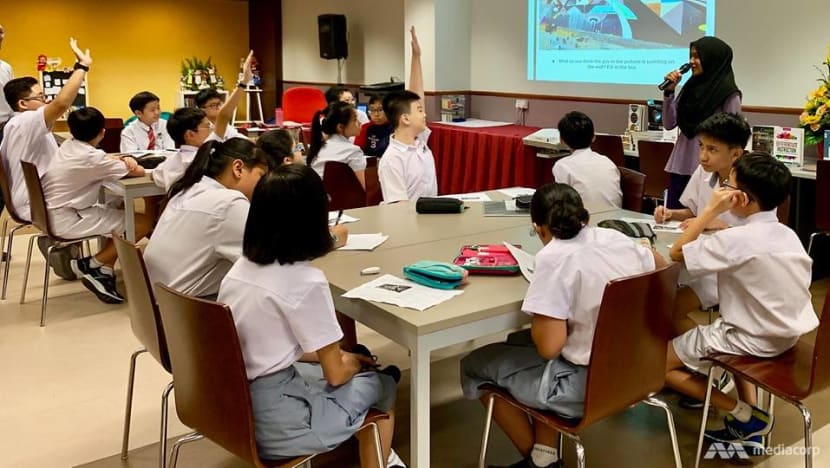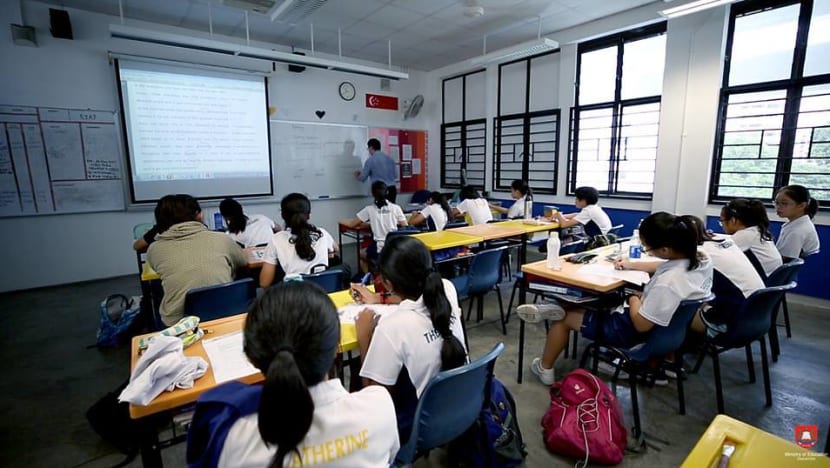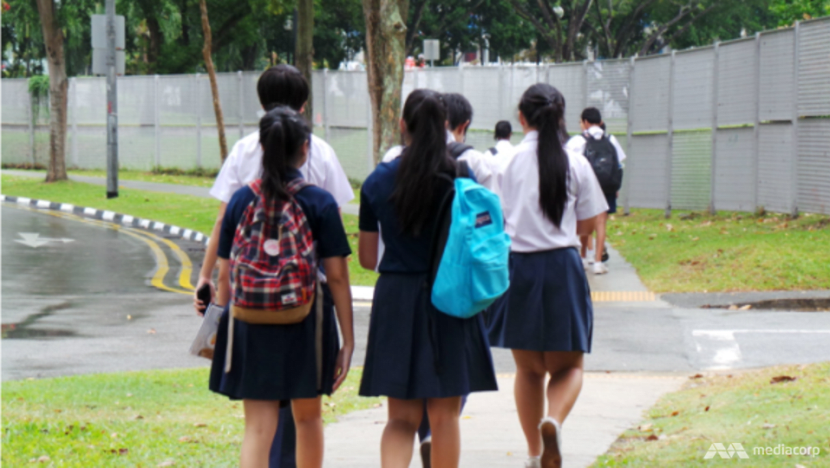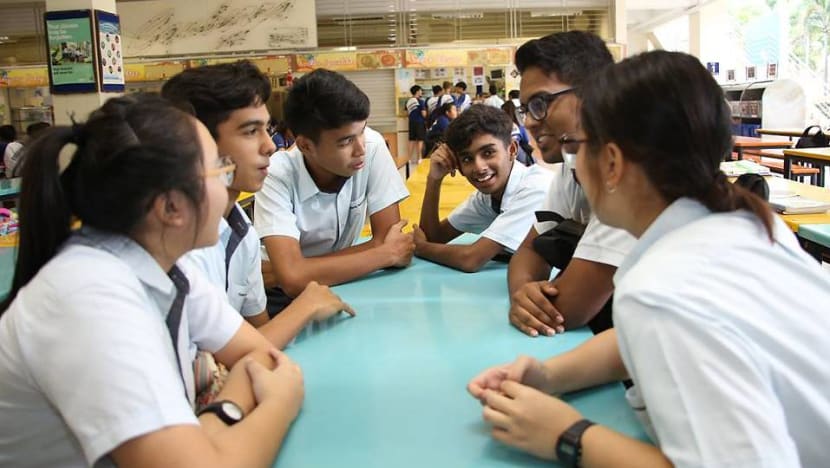commentary Commentary
Commentary: The start of subject-based banding - is grouping classes by CCAs the best option?
Grouping students based on CCAs may end up inadvertently segregating classes of students along socioeconomic, racial and gender lines, says NUS’s Kelvin Seah Kah Cheng.

Students at Edgefield Secondary attending a class. (Photo: Lianne Chia)
SINGAPORE: Education Minister Ong Ye Kung announced the momentous move to end streaming in secondary schools by 2024 in March.
Schools are now encouraged to do away with the practice of grouping students into form classes by academic ability and instead experiment with innovative ways to group students.
The idea is that this will encourage children from different backgrounds to interact with each other. In the long run, this would lead to better social mixing and greater societal cohesion – or so is thought.
CHALLENGES WITH DOING AWAY WITH ABILITY-BASED CLASS GROUPING
Doing away with ability-based grouping necessarily implies that each form class will comprise a more heterogeneous mix of students than before. A pertinent consideration is whether teachers are well prepared to teach such classes.
READ: Streaming — the good, the bad and the ugly side of an outdated policy
At Edgefield Secondary School, for instance, students attend classes in academic subjects such as English and Mathematics, which are grouped by subject-based abilities, but go through about half of their other lessons, including Art and Music, in form classes comprising a mixture of students from all three academic streams.
Teaching a class comprising students from vastly different backgrounds and abilities will naturally be more challenging, since the pace of a given lesson might be too slow for some while too fast for others. Principals must therefore ensure that teachers are trained so that students do not become disengaged.
READ: What we gain and lose in moving away from streaming, a commentary
Form teachers will inevitably need to address thorny questions such as “how should I best pitch my lessons? Should I pitch it so that the content and pace is just right for the average student? Or so I pitch it so that it better challenges the faster learners? Or should I pitch it so as to accommodate the slowest learners?”

In influencing the amount of content taught to students and the pace at which the lesson is delivered, these decisions will have important implications for student learning.
WILL GROUPING BY CCA SOLVE THE PROBLEM OF SOCIAL MIXING WITHIN SCHOOLS?
What should principals consider in deciding how best to organise students into form classes, now that ability-based grouping should be avoided?
In the Committee of Supply debate, a few examples were shared on how some schools had been experimenting with innovative ways of grouping students. Apart from Edgefield Secondary, Minister Ong also cited the example of Boon Lay Secondary School, which had grouped students into form classes based on co-curricular activity (CCA).
While this is an interesting and creative strategy with many merits, principals of other schools who are considering a similar strategy should also be aware of its limitations. Though this strategy might help to reduce the phenomenon of ability-based grouping somewhat, it is unlikely to completely eradicate it.
Why? Because the CCA one participates in involves a choice. It is well known that people from different socioeconomic backgrounds tend to be attracted to different kinds of CCAs. Take golf, sailing, tennis, fencing, or horse-riding for instance.
Who are the kids that tend to take these up as CCAs? Typically the ones from more wealthy families.
These kids have more interest in taking up these activities, perhaps because their parents also engage in them or can send them to such enrichment classes and activities. Because these activities often require access to exclusive clubs or facilities offered by condominium residency, students and parents who engage in them are often those that are more well-to-do.

Therefore, forming classes by CCAs could continue to result in ability and socioeconomic-based grouping, since students in certain CCAs might be from more advantaged backgrounds than others.
Forming classes based on CCAs may also result in unintentional grouping based on race and gender. Again, this results because students of different races and sex tend to be attracted to different types of activities.
For instance, the majority of those who opt for ballet as a CCA tend to be females. Similarly, Chinese, Malay and Indian dance or music are CCAs that tend to attract students of Chinese, Malay and Indian ethnicities respectively.
As such, grouping students based on CCAs, when CCAs involve self-selection based on socioeconomic, racial and gender lines, may end up inadvertently segregating classes of students along those lines.
A POTENTIAL WAY TO GROUP STUDENTS WITHIN SCHOOLS
If the primary objective is to allow for greater social mixing, schools may want to consider grouping students into form classes based on random assignment instead. This process would much be like rolling a die.
If a die is rolled and the number two is obtained, a student is assigned to class two, and so on. In practice, the assignment can be based on a random number generator. This procedure will ensure that the mix of students in each class will be roughly the same as the composition of students making up the school.
In other words, if the ratio of male to female students in the school is 50:50 and the ratio of Chinese, Malay, and Indian students is 70:20:10, for instance, this procedure will yield a mix of students in each class with roughly these same proportions.

Importantly, the average ability of students in each class will end up being the same as that of the school. Hence, there will not be a case where some classes will have disproportionately more high ability students or students from certain sociodemographic backgrounds. This results in an equal mix of students across classes within a school.
To ensure that teachers teaching the core subjects will not face the problem of having to deal with a class which is too heterogeneous, schools can explore grouping students by random assignment for non-core subjects like character and citizenship education, but by the new subject-based academic levels when it comes to examinable subjects.
This way, schools can achieve the best of both worlds – with ample opportunities for students of different backgrounds to socialise on a regular basis but yet still ensuring lesson delivery in core subjects continues to be efficient.
SCHOOLS NEED THE BUY-IN OF PARENTS
Of course, for any social mixing scheme to work as intended, schools need the buy-in of parents. Parents, especially of the more-able academic performers, need to be convinced that social mixing will actually be beneficial for their children.
READ: Streaming out. Subject-based banding in. How are parents reacting? A commentary
Otherwise, they would simply “migrate” from schools with a policy of social mixing towards those schools where students tend to be higher achieving (such as integrated programme schools) so as to avoid having their children mix with students who are less academically inclined.
Already, there is some evidence that such concerns might be genuine, with reports citing how some parents have responded that they prefer to avoid having their children mix with children who are lower-achieving.

If this is true, we might end up with a situation where the higher-achieving children from more advantaged families would have a greater tendency to cluster in some schools, while lower-achieving children from less advantaged families would have a greater tendency to cluster separately in others.
The end result then, might be more social mixing within schools, but paradoxically greater social inequality across schools.
Kelvin Seah Kah Cheng is a Lecturer in the Department of Economics, National University of Singapore. His research focuses on the economics of education.












